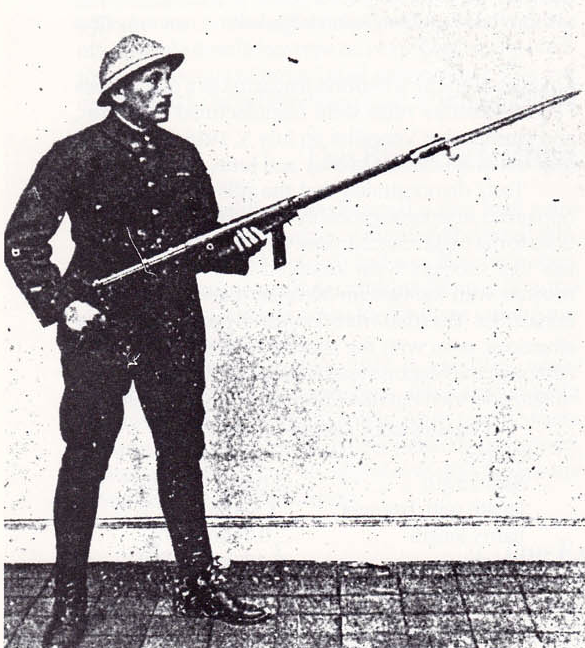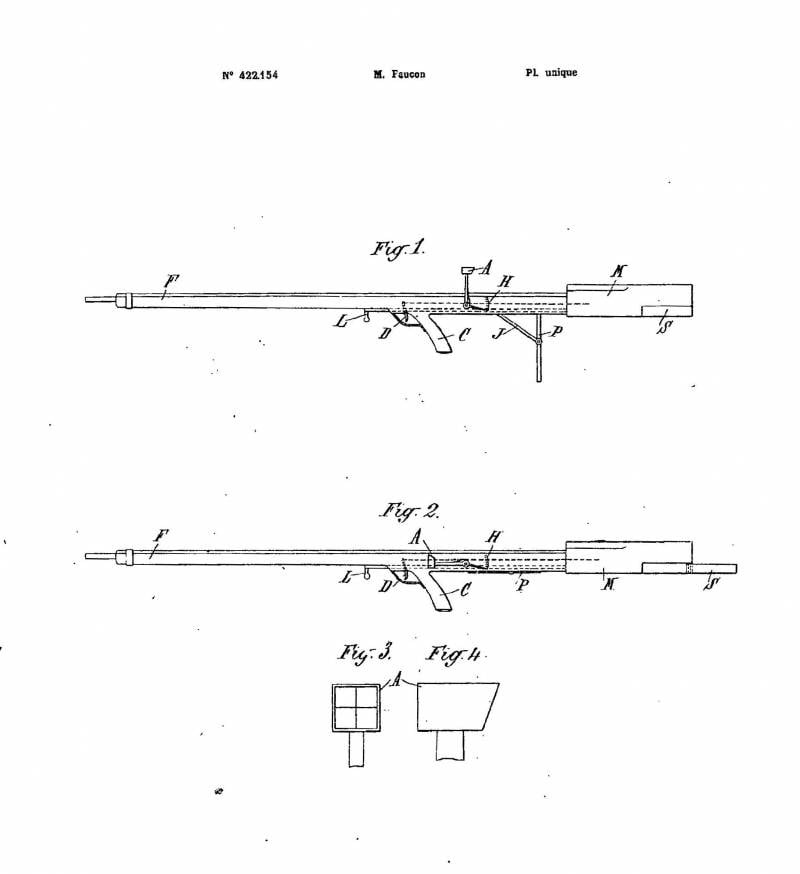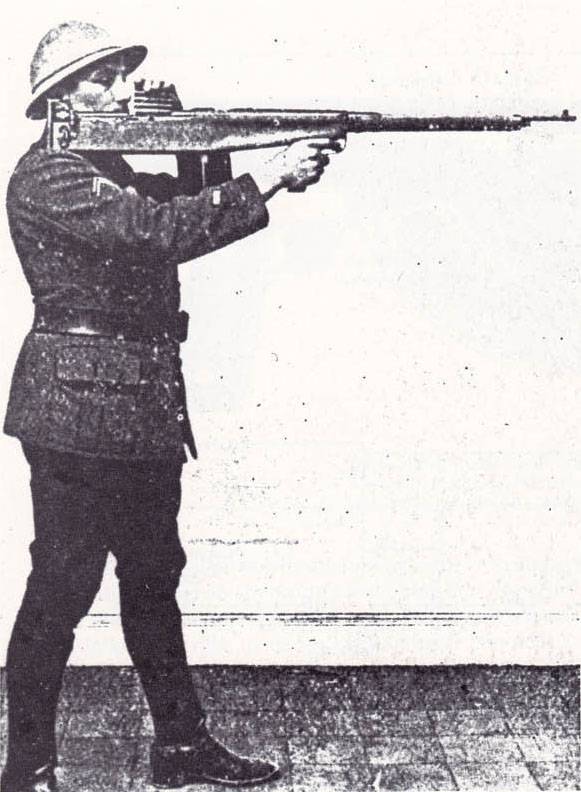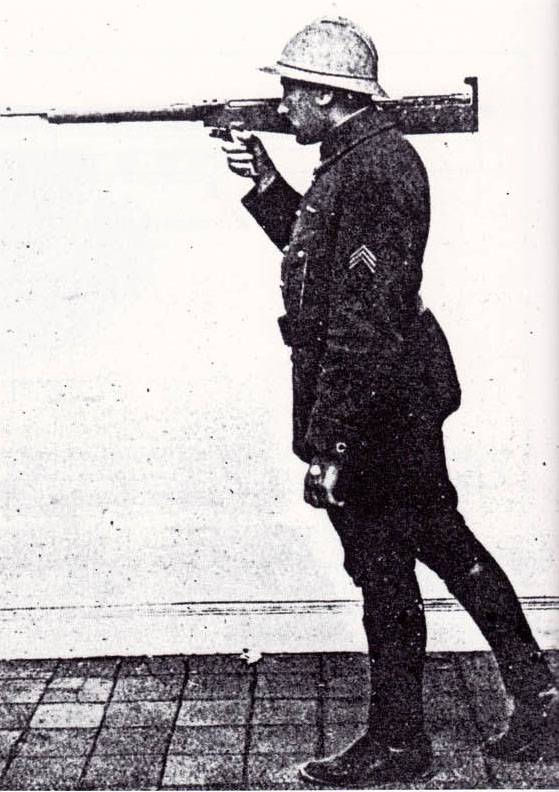The project of a self-loading rifle A.-F. Focon Fusil Équilibré (France)
July 21 20166
At the beginning of the last century, gunsmith designers from leading countries were actively engaged in the creation of new types of automatic weaponsand also worked on the development of promising automation schemes for it. In addition, already at that time, there were pioneers who tried to improve the characteristics of existing systems and solve problems that did not even seem to be relevant a little earlier. One example of such work can be considered the Fusil Équilibré project of the French gunsmith Armand-Frederic Faucon.
A characteristic negative feature of almost any small arms, with rare exceptions, is the need to restore the pickup after each shot / turn. Under the effect of recoil, the weapon moves backward, and the barrel is tossed up. All these features of shooting have a negative effect on the accuracy and accuracy of fire. Attempts to reduce the impact of recoil on the characteristics of the fire are made regularly, so far new versions of self-loading and automatic systems are being developed with maximum neutralization of recoil.
One of the first attempts to solve an important problem was the project Fusil Équilibré (Balanced Rifle), the development of which began in the middle of the 2000s of the last century. The project was developed by Colonel-Lieutenant (Lieutenant Colonel) of the French colonial infantry Armand-Frederick Fockon. At the service, Lieutenant Colonel Foconu had to deal with the shortcomings of existing small arms, which probably led to the emergence of an original proposal for reducing the negative impact of recoil and stabilization of weapons.

The first version of the rifle Fusil Équilibré. Photos Historicalfirearms.info
It is noteworthy that the Fusil Équilibré project did not imply the development of a completely new weapon. A.-F. Focon offered only a set of special design tools that could be used with existing and prospective weapons of various types. By installing the existing rifle units on the Fusil Équilibré design, it was possible to obtain a rifle complex with improved firing accuracy characteristics. A similar alteration in theory could go through any existing samples. Later, during the assembly and testing of the “Balanced Rifle”, this approach was used. New equipment connected with one of the available rifles.
One of the main problems of the existing weapons A.-F. Fockon considered the wrong weight distribution and unacceptable mechanical interaction of the rifle with the shooter during the shot. Due to some new ideas, it was planned to ensure the optimum position of the weapon when firing in various conditions, which did not allow the barrel to deviate too much from the required position. For this, first of all, it was necessary to change the design of the lodge and other rifle assemblies that directly affect the ergonomics and the method of restraint.
For proper weight distribution and reduction of the throw, it was suggested to shoot from the shoulder. Thus, the “Balanced Rifle” should have received the appropriate units. The basis of the system was to become a bed of a specific oblong shape, inside which all main parts were placed. In this case, almost the entire volume of the box was engaged in the details of mechanisms. Since the weapon no longer needed a butt, the corresponding volumes were able to be applied with some benefit. In addition, this arrangement resulted in a reduction in the overall length of the weapon compared to existing rifles.
The original layout proposed by A.-F. Focon, allows us to consider his development of Fusil Équilibré one of the first types of weapons, built according to the bullpup scheme.

The general scheme of the “Balanced Rifle”. Drawing from patent
On the bottom surface of the box, near its center, it was necessary to place a pistol grip with a trigger, covered with a protective bracket. A fuse box was displayed next to them. The controls on the bed were to be connected to the firing mechanism of the rifle used by means of a system of pins and other similar means. Also, the “Balanced Rifle” lodge should have received windows for loading and ejection of cartridges, as well as other necessary components. Before the shoulder of the arrow when using weapons should have been a folding emphasis.
In 1910, the original idea of using a special “conversion kit”, which allows you to turn any self-loading rifle into a weapon with improved accuracy, was enshrined in French patent number XXUMX. A little earlier, the author of the project began preparing for the preliminary tests of Fusil Équilibré, during which it was planned to determine the advantages and disadvantages of the original proposal.
Until A.-F. They did not suggest that the gunsmiths place a rifle on their shoulder instead of the traditional butt against the shoulder. For this reason, no one could say how convenient such a weapon would be and what features of operation future users of the Balanced Rifles would have to face. Since the first checks with the study of weapon ergonomics did not require firing, they were decided to be carried out using a simple layout.
Back in 1909, the designer and his colleagues produced a full-size model of the Fusil Équilibré system. A wooden product with metal elements had the dimensions of a full-fledged rifle of the original design, and its weight corresponded to the design parameters of military weapons. The designer conducted the first tests independently, after which he attracted officers of the Vincenn shooting school to them. Those familiar with the original design, but did not show much interest. The first reviews also did not talk about the enthusiasm of the testers.

Rifle Meunier A5. Photo by Smallarmsreview.com
The wooden full-size model of the Fusil Équilibré rifle had a length of 1040 mm and weighed about 5,5 kg. For comparison, the Lebel serial rifle arr. 1886 / 93, which was in service with the French army, had a length of 1300 mm and weighed (with cartridges) about 4,4 kg. Both samples could be equipped with a bayonet, which additionally increased the length and weight of the entire system. An interesting feature of the “Balanced Rifle” was the advantage in length in comparison with the existing specimen with simultaneous significant superiority in weight. Thus, in the future, the military could criticize the new project due to the unacceptable growth of the mass of weapons and therefore refuse to implement it.
The project needed improvements and improvements in the basic characteristics. Armand-Frederic Fockon continued to work on the development of the Fusil Équilibré system and was engaged in the project until the very beginning of the First World War. In the middle of 1914, France entered the war, because of which the development of many new projects was suspended or postponed. So, A.-F. Fokonu had to perform his direct duties, not being able to continue the design of advanced small arms. It was possible to continue work only after the end of the war.
Only in 1918, the Fusil Équilibré project was continued. By this time, the author managed to apply a number of new ideas aimed at improving performance. In addition, the ergonomics of the promising “conversion kit” was refined. All these works, which were carried out by Lieutenant Colonel Fokon during the war, made it possible to bring the project to the stage of preparation for the new tests. At this time, the opportunity to produce high-grade prototypes of small arms, suitable for the study of both usability and real combat characteristics.

Shooter with a rifle Fockon-Meunier. Photos Historicalfirearms.info
To continue work on his project A.-F. Faucon received two Meunier A5 self-loading rifles of the 1908 model. This weapon was developed by the designers of the Section Technique de l’Artillerie under the leadership of Etienne Meunier and was an intermediate version of a promising self-loading rifle for the army. Later E. Meunier created a new version of the rifle, and all the previous samples made for testing were unnecessary. A couple of such rifles, which no longer had any future, were given to A.-F. Focon for use in his experiments.
The Meunier A5 rifle used the 6,5x61 mm cartridge and was equipped with gas automatics. A butterfly valve was used to lock the barrel with a set of lugs. The cartridges were fed from an integral box store. The trigger mechanism was built on the trigger pattern. The rifle had an open mechanical sight and was completed with a wooden box with an upper lining of the barrel.
The first model of the Fockon-Meunier rifle was assembled by the middle of the 1918 year. The basic A5 semi-automatic rifle lost its wooden fittings, and also received new control systems for the trigger mechanism. The remaining parts of the rifle were installed on a new bed of a characteristic shape, equipped with a pistol grip, a shoulder rest, etc. It was suggested to shoot from the right shoulder. For this reason, a hinged sight appeared on the left side of the receiver, and the front sight was shifted relative to its original position. It was proposed to reload the weapon using clips placed in a window at the back of the weapon.

Shooter with a weapon, left view. Photos Historicalfirearms.info
Later, another prototype of the Faucon-Meunier system was manufactured. From the first product he differed in another form of a wooden lodge, which served as the basis for the weapon. Thus, the shape of the front part of the box, to which the fire control handle was attached, has changed. The height of the rear part of the box has decreased, which now did not cover the upper elements of the receiver. Also, some changes were made to the pistol grip and internal mechanisms of the Fusil Équilibré system. The base rifle was kept in the existing configuration.
The second sample was presented to potential customers at the end of the spring 1920 of the year. After the show was shown to the military, both experienced self-loading Balanced Rifles were tested at a shooting range. The designer, together with representatives of the army, studied the features of the exploitation of a new weapon, and also determined its real characteristics in certain conditions. According to the results of two tests, certain conclusions were made.
During the tests of both prototypes of the Fusil Équilibré system based on E. Meunier’s rifle, it was found that the existing fire control systems have insufficient reliability characteristics. The use of the firing mechanism in the initial configuration suited the potential customer, however, equipping the weapon with a set of rods for “remote” fire control led to negative consequences. Traction could not provide the required reliability of work. Because of this, there were failures of mechanisms, manifested in the form of delays in shooting.
Nevertheless, during the tests it was found that the new rifle is simpler and more convenient when used for its intended purpose. It turned out that during long-term shooting from the “Balanced Rifle” the shooter gets less tired than in the case with similar weapons of the classical layout. The original location of the weapon contributed to a different distribution of weight and momentum recoil, thereby significantly reduced arrow fatigue.

1920 Rifle. Photo Smallarmsreview.com
In 1920, representatives of the French army got acquainted with the next version of the original small arms and made conclusions about its future. The commission responsible for the tests decided that the Fusil Équilibré system developed by A.-F. Focon is not of interest to the army and can not be adopted. The exact reasons for this decision are unknown, but it can be imagined, because of which the army refused an interesting project. First of all, the non-standard layout of weapons could adversely affect the fate of the development. She demanded to retrain personnel, as well as to update some methods of combat use of weapons. In addition, a serious disadvantage was the low reliability of the imposition of the trigger and its burdens.
According to the test results, France did not adopt the “Balanced Rifle” of the Armand-Frederick Faucon construction. With some advantages over the existing “classic” layout systems, the Fusil Équilibré product had serious drawbacks that could have a significant negative impact on the combat use of weapons. As a result, the mass production and subsequent operation of such systems proved to be inexpedient.
After the refusal of the military in 1920, all work on the Fusil Équilibré project was discontinued. Attempts to improve insufficiently reliable mechanisms were not undertaken. Both samples, apparently, were disassembled as unnecessary. The Fusil Équilibré project was not developed due to serious flaws. The original set of additional equipment, capable of turning a semi-automatic rifle into a system with enhanced accuracy characteristics, has not left the test stage.